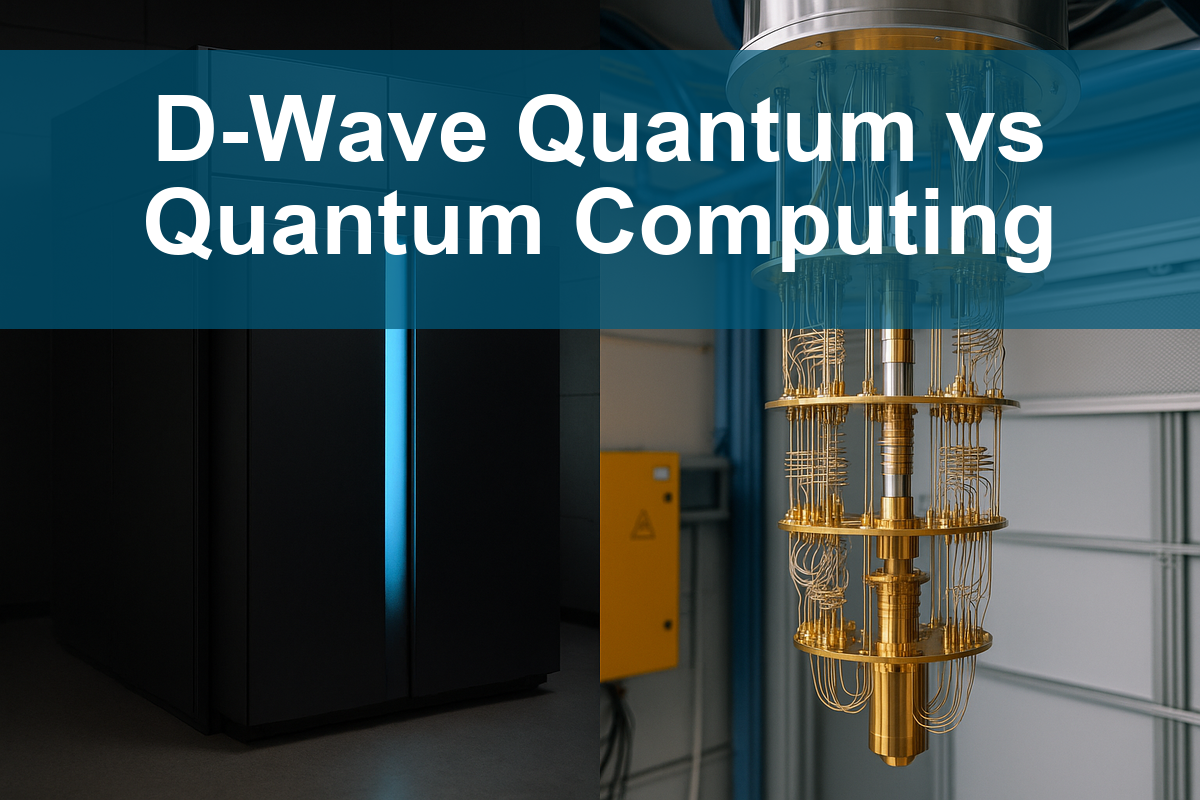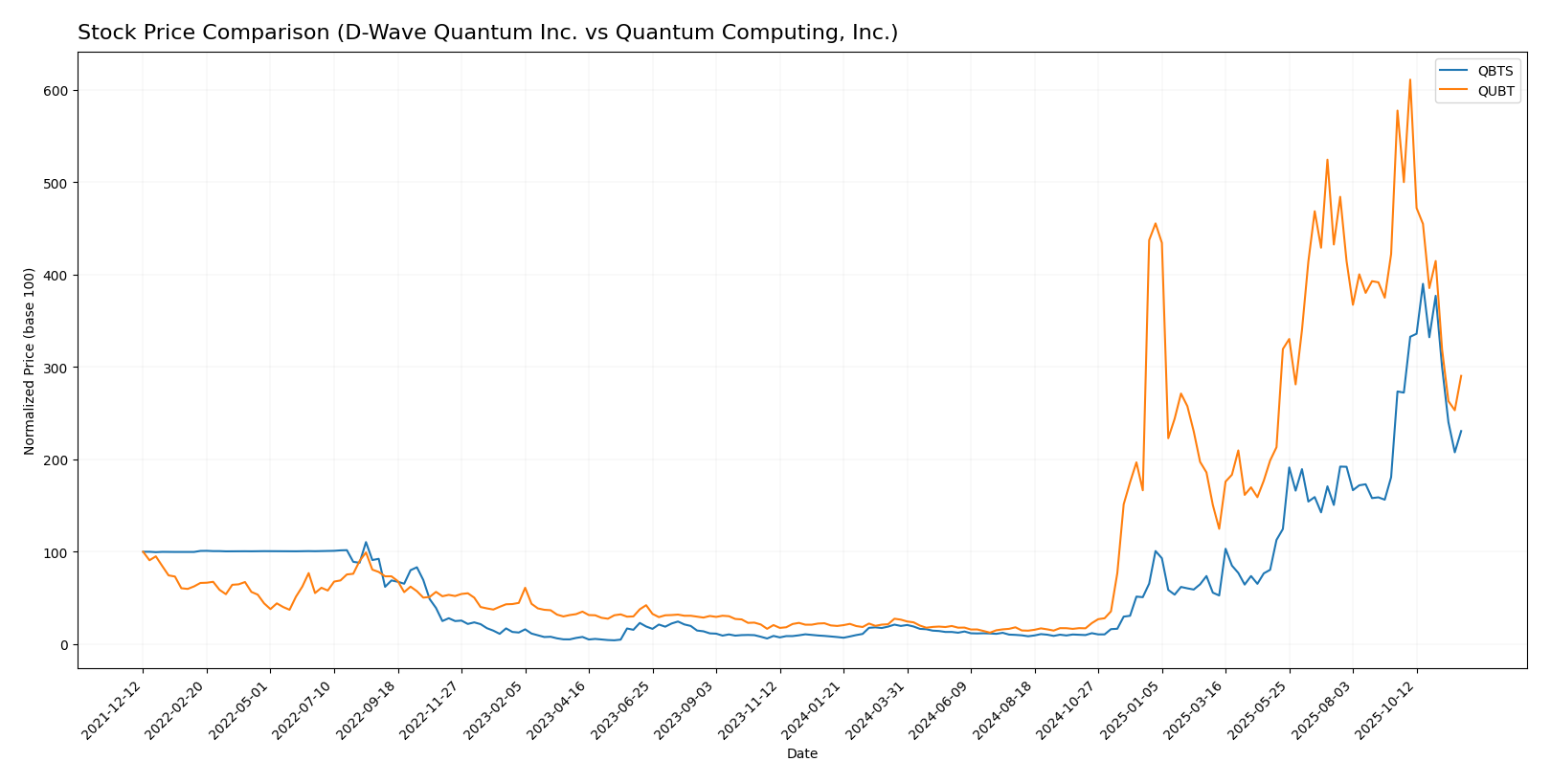In the rapidly evolving field of quantum computing, two companies stand out: D-Wave Quantum Inc. (QBTS) and Quantum Computing, Inc. (QUBT). Both companies operate within the Computer Hardware industry, but they take different approaches to innovation and market engagement. D-Wave focuses on developing comprehensive quantum systems and services, while Quantum Computing, Inc. emphasizes software tools for quantum applications. As investors, it’s crucial to understand these differences. In this article, I will help you determine which company presents the more compelling investment opportunity.

Table of contents
Company Overview
D-Wave Quantum Inc. Overview
D-Wave Quantum Inc. is at the forefront of the quantum computing revolution, aiming to harness the power of quantum mechanics to solve complex problems across various industries. The company’s mission is to develop and deliver cutting-edge quantum computing systems, software, and services, including its fifth-generation quantum computer, Advantage. D-Wave’s offerings are geared towards sectors such as artificial intelligence, drug discovery, and financial modeling, facilitating innovative solutions for enterprises. Headquartered in Burnaby, Canada, D-Wave prides itself on a vibrant developer community and comprehensive cloud-based services, enabling businesses to integrate quantum solutions seamlessly into their operations.
Quantum Computing, Inc. Overview
Quantum Computing, Inc. specializes in providing software tools and applications that prepare businesses for the quantum future. Their primary product, Qatalyst, serves as a quantum application accelerator, allowing developers to create quantum-ready applications on traditional computers. Founded in 2018 and based in Leesburg, Virginia, the company aims to bridge the gap between classical and quantum computing, targeting both commercial and government clients. With a focus on multiple quantum processing units, Quantum Computing, Inc. is committed to making quantum computing accessible and practical for real-world applications.
Key similarities and differences
Both D-Wave Quantum Inc. and Quantum Computing, Inc. operate within the burgeoning field of quantum computing, yet they adopt distinct approaches. D-Wave emphasizes hardware development and comprehensive quantum solutions, while Quantum Computing, Inc. focuses on software tools that enable quantum readiness on conventional systems. Their respective strategies highlight different facets of the quantum computing landscape, presenting varied opportunities and risks for investors.
Income Statement Comparison
The following table compares the most recent income statements of D-Wave Quantum Inc. (QBTS) and Quantum Computing, Inc. (QUBT), highlighting key financial metrics.
| Metric | D-Wave Quantum Inc. (QBTS) | Quantum Computing, Inc. (QUBT) |
|---|---|---|
| Market Cap | 7.90B | 1.60B |
| Revenue | 8.83M | 0.37M |
| EBITDA | -138.05M | -62.25M |
| EBIT | -139.98M | -66.05M |
| Net Income | -143.88M | -68.54M |
| EPS | -0.75 | -0.73 |
| Fiscal Year | 2024 | 2024 |
Interpretation of Income Statement
In the latest fiscal year (2024), D-Wave Quantum Inc. reported a slight increase in revenue to 8.83M, while Quantum Computing, Inc. generated only 0.37M. Both companies continue to operate at a loss, with D-Wave’s net income at -143.88M and QUBT at -68.54M. Notably, D-Wave’s EBITDA margin has worsened significantly, reflecting ongoing challenges despite marginal revenue growth. Quantum Computing, Inc., although showing minimal revenue growth, still faces substantial operating expenses, which continue to hinder profitability. Overall, both companies are in a phase of heavy investment with a focus on growth, which has yet to translate into positive earnings.
Financial Ratios Comparison
The following table presents a comparative analysis of key financial metrics for D-Wave Quantum Inc. (QBTS) and Quantum Computing, Inc. (QUBT) based on their most recent fiscal year data.
| Metric | D-Wave Quantum Inc. (QBTS) | Quantum Computing, Inc. (QUBT) |
|---|---|---|
| ROE | -2.30 | -0.64 |
| ROIC | -0.45 | -0.17 |
| P/E | -11.22 | -2.25 |
| P/B | 25.76 | 0.89 |
| Current Ratio | 6.14 | 17.36 |
| Quick Ratio | 6.08 | 17.36 |
| D/E | 0.61 | 0.04 |
| Debt-to-Assets | 0.19 | 0.04 |
| Interest Coverage | -19.82 | -10.39 |
| Asset Turnover | 0.04 | 0.00 |
| Fixed Asset Turnover | 0.77 | 0.06 |
| Payout Ratio | 0 | -0.03 |
| Dividend Yield | 0 | 1.42% |
Interpretation of Financial Ratios
The ratios indicate that both companies are experiencing significant operational challenges, with negative returns on equity (ROE) and invested capital (ROIC). QBTS shows a higher price-to-book (P/B) ratio, implying it is valued higher than its net assets, while QUBT’s current and quick ratios suggest it is better positioned to cover short-term liabilities. However, both companies have high debt relative to assets, raising concerns about financial stability and risk management.
Dividend and Shareholder Returns
D-Wave Quantum Inc. (QBTS) does not pay dividends, indicating a focus on reinvestment for growth. Their negative net income and high capital expenditures reflect a high-growth phase, prioritizing technological advancements over immediate shareholder returns. Quantum Computing, Inc. (QUBT), also not paying dividends, similarly channels resources into R&D, yet offers a modest dividend yield of 1.42%. Both companies engage in share buybacks, but their strategies should be scrutinized for sustainability amidst ongoing losses. Overall, these approaches may support long-term value creation if growth translates into profitability.
Strategic Positioning
D-Wave Quantum Inc. (QBTS) holds a significant position in the quantum computing market with a market cap of 7.9B, showcasing its strong product offerings like the Advantage quantum computer. Quantum Computing, Inc. (QUBT), valued at 1.6B, focuses on software tools and applications, targeting a niche in the quantum-ready application space. Both companies face competitive pressure as technological advancements accelerate, demanding continuous innovation to maintain their market relevance.
Stock Comparison
In analyzing the stock price movements of D-Wave Quantum Inc. (QBTS) and Quantum Computing, Inc. (QUBT) over the past year, we observe significant fluctuations, particularly in the context of recent trading dynamics.

Trend Analysis
For D-Wave Quantum Inc. (QBTS), the overall price change over the past year stands at an impressive +2660.26%. This indicates a bullish trend despite a recent decline of -31.22% from September 14, 2025, to November 30, 2025, which suggests a neutral trend in the short term. The stock reached a high of 38.33 and a low of 0.69, showing notable volatility with a standard deviation of 9.45. The acceleration status indicates a deceleration in momentum.
In contrast, Quantum Computing, Inc. (QUBT) exhibits an overall price change of +1330.32%, also reflecting a bullish trend. However, the recent trend from September 14, 2025, to November 30, 2025, shows a decline of -31.22%, leading to a neutral trend in this timeframe. The stock’s highest price was 24.62, with a low of 0.5, and a standard deviation of 7.07 indicates moderate volatility.
Both companies demonstrate strong long-term performance, but the recent short-term trends suggest caution as they navigate current market conditions.
Analyst Opinions
Recent recommendations for D-Wave Quantum Inc. (QBTS) indicate a cautious outlook, with a rating of C- from analysts, reflecting concerns about its financial performance and low scores in critical areas like return on equity and price-to-earnings ratios. On the other hand, Quantum Computing, Inc. (QUBT) received a slightly better rating of C+, suggesting a hold position as it has a moderate score in price-to-book value. Overall, the consensus for both stocks leans towards a cautious hold rather than a buy, emphasizing the need for careful evaluation before making investment decisions.
Stock Grades
I have gathered some recent stock grades from reliable grading companies for two companies in the quantum computing sector: D-Wave Quantum Inc. (QBTS) and Quantum Computing, Inc. (QUBT). Below are the details of their latest ratings.
D-Wave Quantum Inc. Grades
| Grading Company | Action | New Grade | Date |
|---|---|---|---|
| Benchmark | Maintain | Buy | 2025-11-10 |
| Rosenblatt | Maintain | Buy | 2025-11-07 |
| Canaccord Genuity | Maintain | Buy | 2025-11-07 |
| Cantor Fitzgerald | Maintain | Overweight | 2025-11-07 |
| B. Riley Securities | Maintain | Buy | 2025-09-22 |
| Piper Sandler | Maintain | Overweight | 2025-08-08 |
| Benchmark | Maintain | Buy | 2025-08-04 |
| B. Riley Securities | Maintain | Buy | 2025-07-23 |
| B. Riley Securities | Maintain | Buy | 2025-06-18 |
| Benchmark | Maintain | Buy | 2025-06-18 |
Quantum Computing, Inc. Grades
| Grading Company | Action | New Grade | Date |
|---|---|---|---|
| Lake Street | Maintain | Buy | 2025-11-17 |
| Ascendiant Capital | Maintain | Buy | 2025-10-03 |
| Ascendiant Capital | Maintain | Buy | 2025-06-06 |
| Ascendiant Capital | Maintain | Buy | 2025-04-28 |
| Ascendiant Capital | Maintain | Buy | 2024-11-13 |
| Ascendiant Capital | Maintain | Buy | 2023-11-24 |
Overall, both companies maintain strong buy ratings from multiple grading firms, indicating a positive outlook and consistent investor confidence in their growth potential. The trend suggests stability and ongoing support from analysts in the quantum computing sector.
Target Prices
Based on the latest analyst consensus, here are the target prices for D-Wave Quantum Inc. (QBTS) and Quantum Computing, Inc. (QUBT):
| Company | Target High | Target Low | Consensus |
|---|---|---|---|
| D-Wave Quantum Inc. | 40 | 26 | 35.25 |
| Quantum Computing, Inc. | 40 | 10 | 22 |
Analysts expect D-Wave Quantum Inc. to reach a target consensus of 35.25, significantly higher than its current price of 22.78. Quantum Computing, Inc.’s consensus target of 22 also suggests strong upside potential compared to its current price of 11.69.
Strengths and Weaknesses
The following table outlines the strengths and weaknesses of D-Wave Quantum Inc. (QBTS) and Quantum Computing, Inc. (QUBT) based on the most recent data.
| Criterion | D-Wave Quantum Inc. (QBTS) | Quantum Computing, Inc. (QUBT) |
|---|---|---|
| Diversification | Moderate | Low |
| Profitability | Negative margins | Negative margins |
| Innovation | Advanced quantum technology | Software tools for quantum systems |
| Global presence | Strong global footprint | Limited geographic presence |
| Market Share | Growing niche market share | Emerging player in the sector |
| Debt level | Moderate (debt-to-equity: 0.613) | Very low (debt-to-equity: 0.011) |
Key takeaways from the analysis indicate that while both companies face profitability challenges, D-Wave has a more robust global presence and advanced technological offerings, whereas Quantum Computing, Inc. remains a smaller player with limited geographic reach but lower debt levels.
Risk Analysis
The following table outlines key risks associated with D-Wave Quantum Inc. and Quantum Computing, Inc.
| Metric | D-Wave Quantum Inc. | Quantum Computing, Inc. |
|---|---|---|
| Market Risk | High | Moderate |
| Regulatory Risk | Moderate | High |
| Operational Risk | High | Moderate |
| Environmental Risk | Low | Low |
| Geopolitical Risk | Moderate | Low |
Both companies face significant market and operational risks due to the volatile nature of the quantum computing sector. Recent advancements and regulatory scrutiny could impact their growth and profitability.
Which one to choose?
When comparing D-Wave Quantum Inc. (QBTS) and Quantum Computing, Inc. (QUBT), both companies show significant challenges. QBTS has a market cap of 1.61B, with a revenue of 8.83M and a negative net profit margin of -16.3%. In contrast, QUBT, with a market cap of 1.55B and revenue of 0.37M, also posts a troubling net profit margin of -183.8%.
In terms of analyst ratings, QBTS has a grade of C-, while QUBT stands at C+, indicating slightly better overall expectations for QUBT. The stock trends are bullish for both, but QUBT has recently seen a downward price trend of -31.22%.
For investors leaning toward growth potential, I would recommend QBTS, while those valuing more stable fundamentals might lean towards QUBT. However, both face risks related to competition and market dependence.
Disclaimer: This article is not financial advice. Each investor is responsible for their own investment decisions.
Go further
I encourage you to read the complete analyses of D-Wave Quantum Inc. and Quantum Computing, Inc. to enhance your investment decisions:



